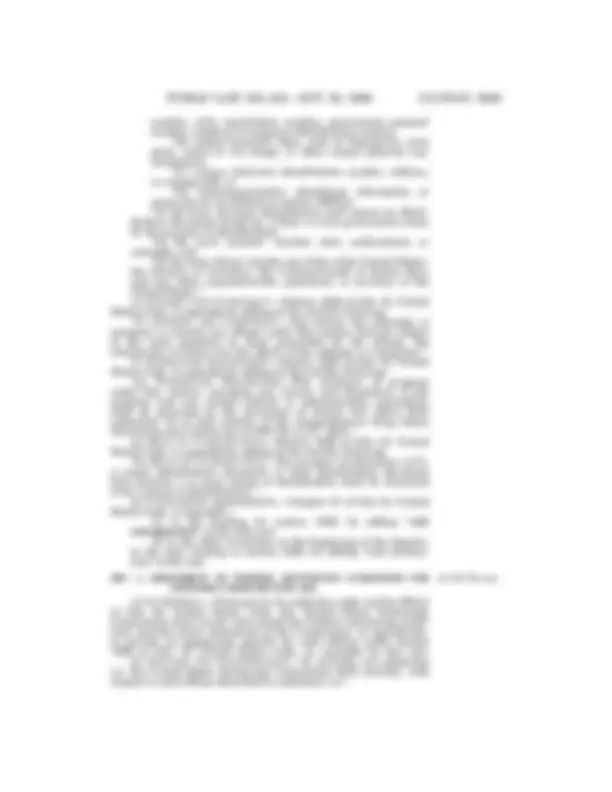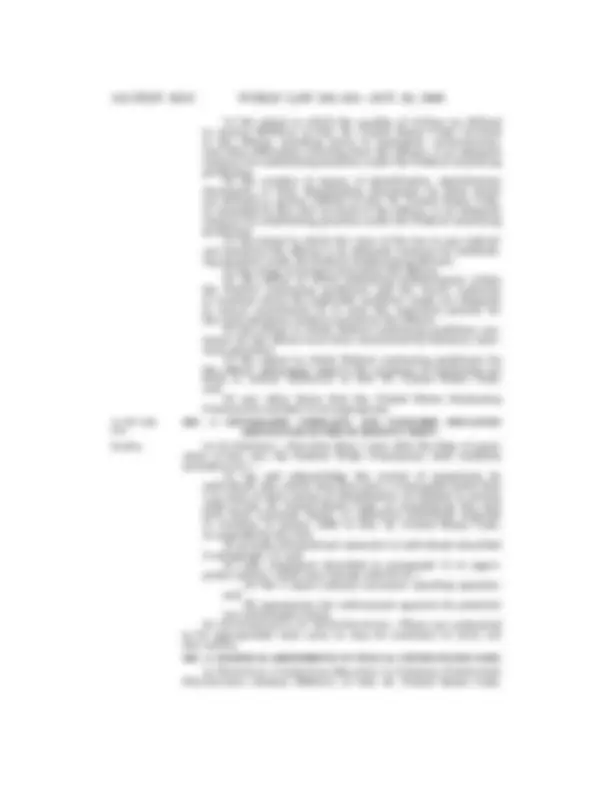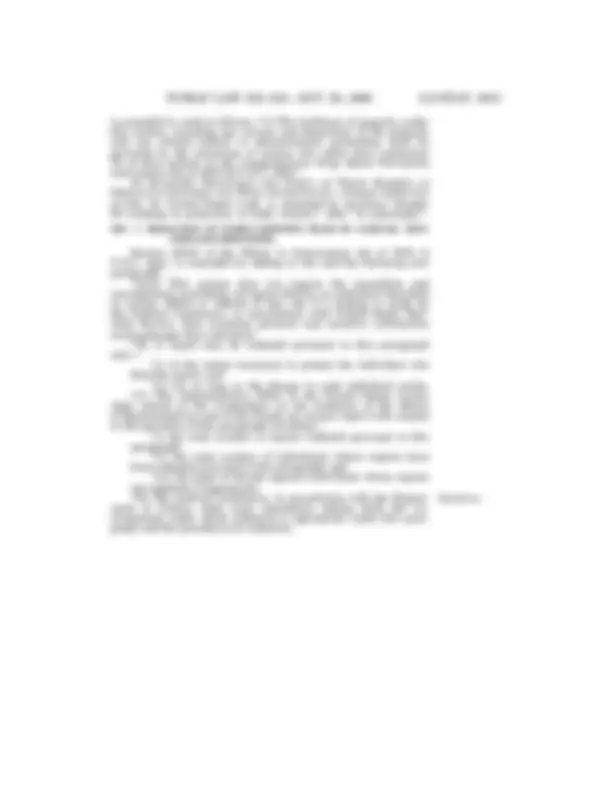





Study with the several resources on Docsity

Earn points by helping other students or get them with a premium plan


Prepare for your exams
Study with the several resources on Docsity

Earn points to download
Earn points by helping other students or get them with a premium plan
Community
Ask the community for help and clear up your study doubts
Discover the best universities in your country according to Docsity users
Free resources
Download our free guides on studying techniques, anxiety management strategies, and thesis advice from Docsity tutors
The text of Public Law 105–318, enacted on October 30, 1998, which amends Chapter 47 of Title 18, United States Code, relating to identity fraud. The Act expands the definition of identity fraud and increases penalties for related offenses. It also grants the United States Sentencing Commission the authority to review and amend the Federal sentencing guidelines for identity fraud offenses.
What you will learn
Typology: Exercises
1 / 6

This page cannot be seen from the preview
Don't miss anything!




Public Law 105–
105th Congress
An Act
To amend chapter 47 of title 18, United States Code, relating to identity fraud, and for other purposes.
Be it enacted by the Senate and House of Representatives of the United States of America in Congress assembled ,
SECTION 1. SHORT TITLE.
This Act may be cited as the ‘‘Identity Theft and Assumption Deterrence Act of 1998’’.
SEC. 2. CONSTITUTIONAL AUTHORITY TO ENACT THIS LEGISLATION.
The constitutional authority upon which this Act rests is the power of Congress to regulate commerce with foreign nations and among the several States, and the authority to make all laws which shall be necessary and proper for carrying into execution the powers vested by the Constitution in the Government of the United States or in any department or officer thereof, as set forth in article I, section 8 of the United States Constitution.
SEC. 3. IDENTITY THEFT.
(a) ESTABLISHMENT OF OFFENSE.—Section 1028(a) of title 18, United States Code, is amended— (1) in paragraph (5), by striking ‘‘or’’ at the end; (2) in paragraph (6), by adding ‘‘or’’ at the end; (3) in the flush matter following paragraph (6), by striking ‘‘or attempts to do so,’’; and (4) by inserting after paragraph (6) the following: ‘‘(7) knowingly transfers or uses, without lawful authority, a means of identification of another person with the intent to commit, or to aid or abet, any unlawful activity that con- stitutes a violation of Federal law, or that constitutes a felony under any applicable State or local law;’’. (b) PENALTIES.—Section 1028(b) of title 18, United States Code, is amended— (1) in paragraph (1)— (A) in subparagraph (B), by striking ‘‘or’’ at the end; (B) in subparagraph (C), by adding ‘‘or’’ at the end; and (C) by adding at the end the following: ‘‘(D) an offense under paragraph (7) of such subsection that involves the transfer or use of 1 or more means of identification if, as a result of the offense, any individual committing the offense obtains anything of value aggregat- ing $1,000 or more during any 1-year period;’’; (2) in paragraph (2)—
18 USC 1028 note.
18 USC 1001 note.
Identity Theft and Assumption Deterrence Act of
Oct. 30, 1998 [H.R. 4151]
(A) in subparagraph (A), by striking ‘‘or transfer of an identification document or’’ and inserting ‘‘, transfer, or use of a means of identification, an identification docu- ment, or a’’; and (B) in subparagraph (B), by inserting ‘‘or (7)’’ after ‘‘(3)’’; (3) by amending paragraph (3) to read as follows: ‘‘(3) a fine under this title or imprisonment for not more than 20 years, or both, if the offense is committed— ‘‘(A) to facilitate a drug trafficking crime (as defined in section 929(a)(2)); ‘‘(B) in connection with a crime of violence (as defined in section 924(c)(3)); or ‘‘(C) after a prior conviction under this section becomes final;’’; (4) in paragraph (4), by striking ‘‘and’’ at the end; (5) by redesignating paragraph (5) as paragraph (6); and (6) by inserting after paragraph (4) the following: ‘‘(5) in the case of any offense under subsection (a), forfeit- ure to the United States of any personal property used or intended to be used to commit the offense; and’’. (c) CIRCUMSTANCES.—Section 1028(c) of title 18, United States Code, is amended by striking paragraph (3) and inserting the following: ‘‘(3) either— ‘‘(A) the production, transfer, possession, or use prohib- ited by this section is in or affects interstate or foreign commerce; or ‘‘(B) the means of identification, identification docu- ment, false identification document, or document-making implement is transported in the mail in the course of the production, transfer, possession, or use prohibited by this section.’’. (d) DEFINITIONS.—Subsection (d) of section 1028 of title 18, United States Code, is amended to read as follows: ‘‘(d) In this section— ‘‘(1) the term ‘document-making implement’ means any implement, impression, electronic device, or computer hardware or software, that is specifically configured or primarily used for making an identification document, a false identification document, or another document-making implement; ‘‘(2) the term ‘identification document’ means a document made or issued by or under the authority of the United States Government, a State, political subdivision of a State, a foreign government, political subdivision of a foreign government, an international governmental or an international quasi-govern- mental organization which, when completed with information concerning a particular individual, is of a type intended or commonly accepted for the purpose of identification of individ- uals; ‘‘(3) the term ‘means of identification’ means any name or number that may be used, alone or in conjunction with any other information, to identify a specific individual, includ- ing any— ‘‘(A) name, social security number, date of birth, official State or government issued driver’s license or identification
(1) the extent to which the number of victims (as defined in section 3663A(a) of title 18, United States Code) involved in the offense, including harm to reputation, inconvenience, and other difficulties resulting from the offense, is an adequate measure for establishing penalties under the Federal sentencing guidelines; (2) the number of means of identification, identification documents, or false identification documents (as those terms are defined in section 1028(d) of title 18, United States Code, as amended by this Act) involved in the offense, is an adequate measure for establishing penalties under the Federal sentencing guidelines; (3) the extent to which the value of the loss to any individ- ual caused by the offense is an adequate measure for establish- ing penalties under the Federal sentencing guidelines; (4) the range of conduct covered by the offense; (5) the extent to which sentencing enhancements within the Federal sentencing guidelines and the court’s authority to sentence above the applicable guideline range are adequate to ensure punishment at or near the maximum penalty for the most egregious conduct covered by the offense; (6) the extent to which Federal sentencing guidelines sen- tences for the offense have been constrained by statutory maxi- mum penalties; (7) the extent to which Federal sentencing guidelines for the offense adequately achieve the purposes of sentencing set forth in section 3553(a)(2) of title 18, United States Code; and (8) any other factor that the United States Sentencing Commission considers to be appropriate. SEC. 5. CENTRALIZED COMPLAINT AND CONSUMER EDUCATION SERVICE FOR VICTIMS OF IDENTITY THEFT. (a) IN GENERAL.—Not later than 1 year after the date of enact- ment of this Act, the Federal Trade Commission shall establish procedures to— (1) log and acknowledge the receipt of complaints by individuals who certify that they have a reasonable belief that 1 or more of their means of identification (as defined in section 1028 of title 18, United States Code, as amended by this Act) have been assumed, stolen, or otherwise unlawfully acquired in violation of section 1028 of title 18, United States Code, as amended by this Act; (2) provide informational materials to individuals described in paragraph (1); and (3) refer complaints described in paragraph (1) to appro- priate entities, which may include referral to— (A) the 3 major national consumer reporting agencies; and (B) appropriate law enforcement agencies for potential law enforcement action. (b) AUTHORIZATION OF APPROPRIATIONS.—There are authorized to be appropriated such sums as may be necessary to carry out this section. SEC. 6. TECHNICAL AMENDMENTS TO TITLE 18, UNITED STATES CODE. (a) TECHNICAL CORRECTION RELATING TO CRIMINAL FORFEITURE PROCEDURES.—Section 982(b)(1) of title 18, United States Code,
Deadline.
18 USC 1028 note.
is amended to read as follows: ‘‘(1) The forfeiture of property under this section, including any seizure and disposition of the property and any related judicial or administrative proceeding, shall be governed by the provisions of section 413 (other than subsection (d) of that section) of the Comprehensive Drug Abuse Prevention and Control Act of 1970 (21 U.S.C. 853).’’. (b) ECONOMIC ESPIONAGE AND THEFT OF TRADE SECRETS AS PREDICATE OFFENSES FOR WIRE INTERCEPTION.—Section 2516(1)(a) of title 18, United States Code, is amended by inserting ‘‘chapter 90 (relating to protection of trade secrets),’’ after ‘‘to espionage),’’.
SEC. 7. REDACTION OF ETHICS REPORTS FILED BY JUDICIAL OFFI- CERS AND EMPLOYEES. Section 105(b) of the Ethics in Government Act of 1978 ( U.S.C. App.) is amended by adding at the end the following new paragraph: ‘‘(3)(A) This section does not require the immediate and unconditional availability of reports filed by an individual described in section 109(8) or 109(10) of this Act if a finding is made by the Judicial Conference, in consultation with United States Mar- shall Service, that revealing personal and sensitive information could endanger that individual. ‘‘(B) A report may be redacted pursuant to this paragraph only— ‘‘(i) to the extent necessary to protect the individual who filed the report; and ‘‘(ii) for as long as the danger to such individual exists. ‘‘(C) The Administrative Office of the United States Courts shall submit to the Committees on the Judiciary of the House of Representatives and of the Senate an annual report with respect to the operation of this paragraph including— ‘‘(i) the total number of reports redacted pursuant to this paragraph; ‘‘(ii) the total number of individuals whose reports have been redacted pursuant to this paragraph; and ‘‘(iii) the types of threats against individuals whose reports are redacted, if appropriate. ‘‘(D) The Judicial Conference, in consultation with the Depart- ment of Justice, shall issue regulations setting forth the cir- cumstances under which redaction is appropriate under this para- graph and the procedures for redaction.
Regulations.